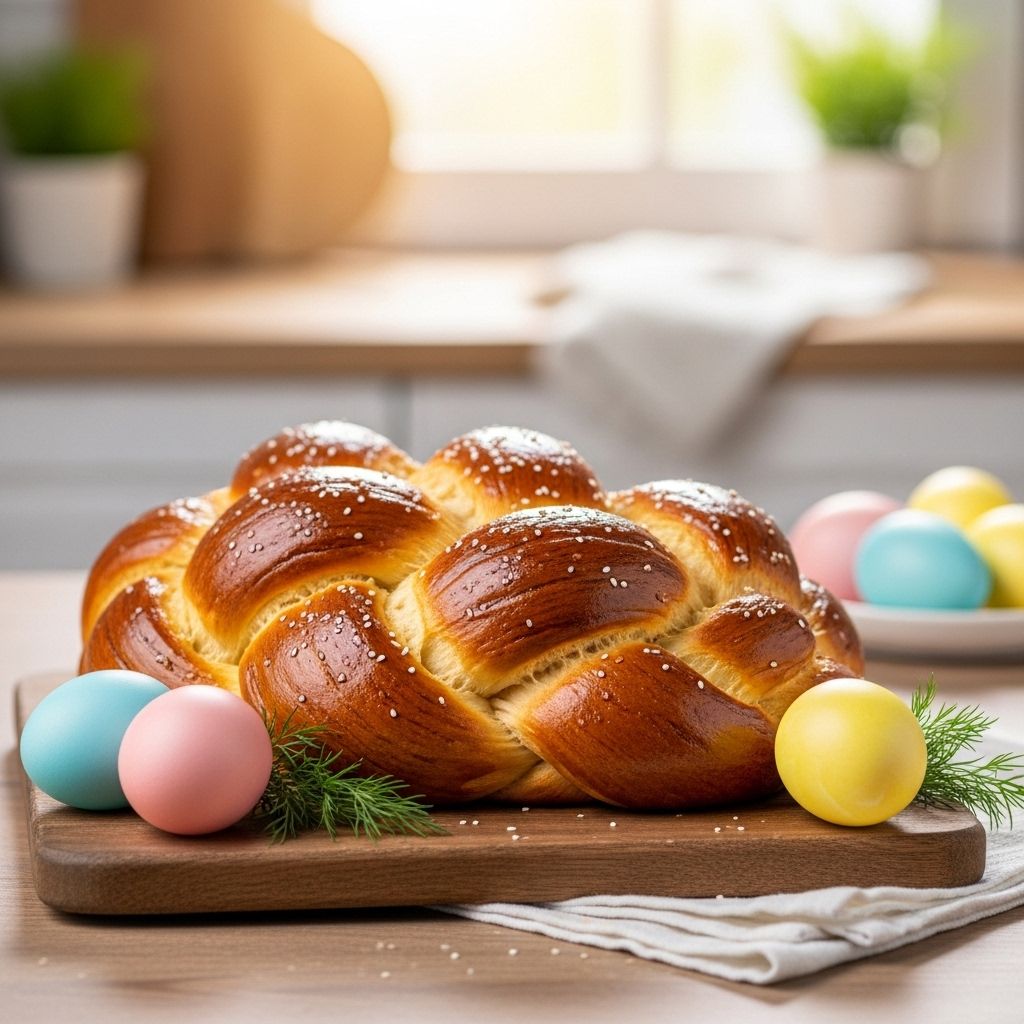Paska Bread Easter Tradition
A festive centerpiece that combines rich flavors and time-honored baking traditions.

Paska Bread: A Cherished Easter Tradition
Paska bread is a beloved tradition in Central and Eastern Europe, especially celebrated during Easter. This sweet, enriched bread is renowned for its beautiful braiding and its role as a centerpiece for holiday gatherings. The recipe is surprisingly simple, requiring common ingredients like yeast, milk, sugar, butter, eggs, flour, and salt.
## Ingredients
–
1/4 cup
warm water (about 110°F)–
1 Tbsp.
active dry yeast–
3/4 cup
warm milk (about 110°F)–
1/2 cup
granulated sugar–
6 Tbsp.
unsalted butter, melted–
3
large eggs, room temperature and divided–
4 3/4 cups
all-purpose flour–
2 1/2 tsp.
kosher salt–
Nonstick cooking spray
## Instructions
Step 1: Activate Yeast
In a stand mixer bowl fitted with a dough hook, combine the warm water and yeast. Let it stand until it becomes foamy, about 5 minutes. Add the warm milk, sugar, melted butter, and 2 eggs. Stir until combined. Add the flour and salt; mix until a shaggy dough forms. Return the bowl to the mixer and beat until the dough is smooth, elastic, and tacky, about 5 minutes.
Step 2: First Rise
Form the dough into a smooth round on a clean surface. Place it in a large bowl lightly greased with nonstick cooking spray. Cover with plastic wrap and let it rise at warm room temperature until doubled in size, 1 to 1 1/2 hours.
Step 3: Prepare the Egg Wash
Spray a 9-inch cake pan with nonstick cooking spray. Beat the remaining egg in a small bowl.
Step 4: Shape the Dough
Divide the dough in half. Gently pat one half into a 4-inch round, folding the edges into the center to form a ball. Flip the dough so it is seam-side down and gently pull it into a taut round. Press the ball into the prepared pan.
Step 5: Braid the Dough
Divide the remaining dough into 3 portions. Roll each into a 30-inch long rope. Braid the ropes together, pinching the ends to seal. Brush the ends with egg if needed.
Step 6: Assemble and Second Rise
Uncover the dough ball in the pan. Arrange the braid flat on top, cutting off excess dough if necessary. Use the egg wash to bind the braid. Cover and let rise for 30 to 45 minutes.
Step 7: Bake
Preheat the oven to 350°F. Uncover the loaf and brush it lightly with the beaten egg. Bake for 45 to 50 minutes, or until golden brown. Cover with foil if necessary to prevent over-browning.
Step 8: Cool
Slide the loaf out of the pan and onto a wire rack to cool completely before slicing.
## Tips and Variations
–
Design with Excess Dough
: Any excess dough from trimming the braid can be shaped into a swirl, rosette, or cross for a decorative touch.–
Egg Wash
: Use the beaten egg to brush the braid and dough for a golden finish.–
Colorful Sprinkles
: Add colorful sprinkles or dyed eggs for a festive look.Frequently Asked Questions (FAQs)
Q: What is Paska bread?
A: Paska bread is a traditional sweet bread from Central and Eastern Europe, often served at Easter.
Q: Why is Paska bread braided?
A: The braiding is a traditional aspect of Paska bread, often symbolizing unity and community.
Q: Can I add any extra flavors to the dough?
A: Yes, you can add raisins or nuts to the dough before the first rise for extra flavor.
Conclusion
Paska bread is not only a delicious addition to Easter celebrations but also a meaningful tradition that brings people together. With its rich ingredients and beautiful presentation, it’s sure to be a highlight of any holiday gathering.
References
- https://www.thepioneerwoman.com/food-cooking/recipes/a60112978/paska-bread-recipe/
- https://www.food.com/recipe/the-bread-ree-drummond-pioneer-woman-443582
- https://www.thepioneerwoman.com/food-cooking/g64476080/easter-breads/
- https://groups.io/g/EOMC-Kitchen/topic/pioneer_woman_easter_bread/98149707
- https://www.thepioneerwoman.com/food-cooking/recipes/a39002935/easter-bread-recipe/
- https://www.thepioneerwoman.com/food-cooking/meals-menus/g65631380/best-bread-recipes/
Read full bio of Sneha Tete












